Statement from the American Federation of School Administrators
The latest National Assessment of Educational Progress results (“The Nation’s Report Card”), showcasing that reading and math scores have dropped to the lowest level in years, are no surprise to the administrators and leaders who are on the front line running our districts and schools every day.
Educating America’s children in a post-COVID-19 world that’s facing a critical educator shortage, students and staff with social-emotional issues, and a broken educational infrastructure that was in place well before the pandemic makes increasing academic achievement a difficult goal to reach.
As principals, vice principals, directors, supervisors and other school leaders, we know the best way to turn this trend around is a heavy-duty investment in our students and educators. It starts with increasing investment in Title IV of the Every Student Succeeds Act (ESSA). This money would focus on improving students’ academic achievement by expanding the capacity of states, local educational agencies, schools and local communities. Moreover, these funds are critical to improving school facilities, upgrading technology and creating modern learning environments—thus moving our schools into a modern world.
Additionally, we need to expand the use of educator professional learning that concentrates on improving instructional practices, increasing student engagement, and developing collaborative learning communities and educational equity. Not only will this approach enhance student outcomes, but research also shows it helps to retain quality teachers and school leaders.
Unfortunately, we are hearing that certain members of the House of Representatives are considering drastic cuts in Title II, Part A of the Elementary and Secondary Education Act of 1965 (ESEA), which is the federal government’s largest direct investment in professional learning, supporting such activities as instructional coaching, mentoring and collaborative planning time.
In a time of need, it is imperative to support Title II investment. Increasing professional learning dollars can make a real difference in the life of the children we serve in our classrooms.
